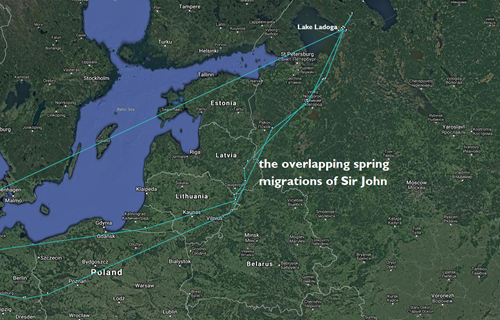
When Sir John transmitted from North Norfolk, on the 3rd March 2019, he was within a kilometre of the site where we caught and tagged him in 2017. Shortly after this, Sir John disappeared.
We now know that his disappearance had nothing to do with Sir John or his tag, but a technical fault at the receiving end of our tracking system. Following the discovery of a large cache of stored-but-unpublished location data, we have been able to retrace Sir John’s movements since March.
In fact, Sir John had transmitted frequently during his Spring migration this year. The new data reveal that, at some point between 3rd and 11th March, Sir John flew from Norfolk to Kaliningrad, Russia. He settled here for at least nine days before continuing his journey across Lithuania. On the 22nd March, he paused for a further 13 days on the Lithuanian-Belarusian border. By 6th April he was in Russia but made one more stopover, south of St. Petersburg, before reaching Lake Ladoga on the 17th.
We have tracked Sir John over two previous spring migrations (2017 and 2018) and in both cases, he visited this same breeding location close to Lake Ladoga and his 2019 route shows a great deal of consistency with that of 2018. Sir John’s 2019 stopover on the Lithuanian-Belarusian border is within 30km of a site he visited in 2018. His next stopover, south of St. Petersburg, is within 10km of a 2018 site. These sites are by no means identical – he is not returning to a specific wood or field that he remembers – but it appears as though prior experience tells Sir John that this approximate area has provided suitable resting habitat in the past.